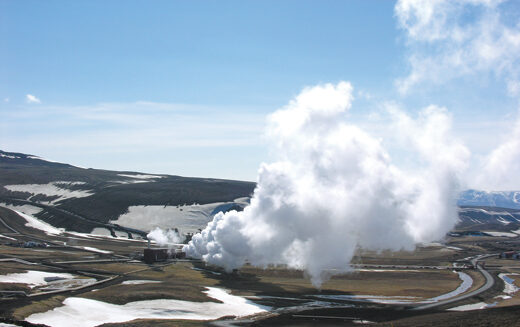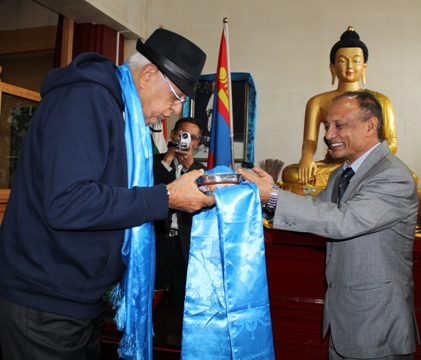At the fag end of his political career, Kashmir’s three-time Chief Minister Dr Farooq Abdullah finally landed as head of one of India’s “insignificant” ministries. People crack jokes about the ‘gobar gas’ ministry that, they believe, was a quid pro quo to help Abdullah Jr to consolidate his empire. But officials and experts tell R S Gull that Dr Abdullah could contribute immensely to his state if he takes his new job seriously.

In this era of climate change, clean energy is the buzzword. India is the fastest growing power after China, Dr Farooq Abdullah as head of its New & Renewable Energy Ministry (NREM) – upgraded from MoS status to suit his stature – holds a vital position. This can help J&K, a state he ruled for the longest-ever period.
For geographic reasons, Ladakh could be revolutionized as NREM is the main agency to tap its solar as well as geothermal energy.
Since hydro projects below 25 MW also fall under this ministry, Dr Abdullah can facilitate the execution of dozens of small projects in Kashmir, Doda, Rajouri and Poonch. All the projects in Jammu are much bigger, but a proper survey by professionals from the private sector could fetch a plan for harvesting wind energy in the Ramban-Batote-Kud belt.
By now, millions of rupees have been invested in Ladakh, especially Leh by government agencies through a network of NGOs. There are many successful cases in which solar energy is being used to warm houses, cook food, run faxes and computers, and at least in one case, to power water pumps. Ladakh Ecological Development Group (LEDeG) works on solar energy and has devised Trombe (solar) walls and direct gain system for solar space heating has its office powered by a 960-watt solar photovoltaic plant on its roof. But failure of state intervention has prevented in installation of even a unit of one MW, so far.
We have already formulated the DPRs for two units of five MWs each at Nubra (Leh) and Zanaskar (Kargil) under Rajiv Gandhi Grameen Vidyutikaran Yojana (RGGVY),” says a senior power ministry official. It would cost Rs 120 crores each. The proposal is with CEA which is sending its high-level team for talks. “The idea is to create grid interactive solar power projects and these could become pioneer projects in our state,” says the official.

Over the last few years, there is a lot of forward movement in state government plans of tapping the geothermal energy in Puga Valley. Though the overall availability could be around 150 MWs, one-third of it (50 MW) is identified and ready to be tapped. This energy would come at a throwaway cost of less than one-third of hydropower, which at present is the mainstay of the power-deficient state’s energy requirements.
The transmission of cheap energy to as far as 175 km would, however, come at a cost. Informed sources told Kashmir Life that at least two parties have approached the policymakers with proposals. “They are not only ready to invest in tapping the energy but also in transmitting it to Leh,” said one official. “We would be receiving the energy at Leh and not in Puga.”
After continuous monitoring and investigations for over two decades, experts have identified geothermal reservoirs in the Puga valley of Ladakh, enough to produce over 50 MW of power. Adjacent to the famous Salt Lake Valley of Rupshu, inhabited by the Chang Pa tribe beyond Tanglang La and Polokonka passes, the Puga Valley draws hundreds of people suffering from rheumatism and skin diseases for hot water baths.
It has huge borax and sulphur deposits but inaccessibility and short-working seasons prevent any commercial exploitation of the belt. “Geological Survey of India has extensively studied the area and for many years they have been using hot waters for space heating of their huts,” one officer who has frequently visited the spot said. “They have drilled holes up to 300 meters and believe the temperature is over 200 degrees Celsius. But for commercial exploitation, it would need drilling up to one kilometre,” he added. On the other side of the border in the same belt, China has already set up one geothermal power station.
“We will be going for tariff-based competitive bidding,” one officer in the power ministry said. “If the NREM gives some subsidy to the project, the costs of the energy that would be evacuated to Leh would go down and the project will become more viable.”
Puga, if tapped, would become the biggest geothermal energy site in India. India has six other places with a cumulative capacity to produce 10,600 MW scattered over different areas.
However, before the state government formally approaches Dr Abdullah for help, it will have to settle its dispute with Ladakh Autonomous Hill Development Council (LAHDC) Leh which is keen to implement the Puga initiative.
“PDC had decided to execute it under the BOOT system as an independent power project. As one of the officials of LAHDC was trained by the World Bank in geothermal energy, the council thinks it will be better placed to implement it,” one officer said.
In smaller hydro projects, officials believe that Dr Abdullah can help J&K on two fronts. He can offer adequate support in framing the DPRs for all these smaller projects that are already identified. And then, in the case of local investors (read IPPs), his ministry can help evolve a ‘minimum guaranteed tariff’ for five years by subsidizing the regulator’s fixed price by 20 per cent.
“It will become such an attractive package that most of the small projects would be implemented locally,” one planner said. It is interesting to mention that barring four projects – Kishangnaga, Uri-II (both with NHPC) and New Ganderbal and Upper Sindh – all other projects fall below 25-MWs and are directly under the ministry that Dr Abdullah now heads.

But Dr Abdullah will have to effect many changes in NREM to make it viable to needs in mainland India and J&K. The ministry has a profile of being a ‘science’ ministry with many academics actually holding top slots.
“It needs professionals with proper experience to make an impact,” said one IAS officer who had a prolonged stint with the central government. “If a senior officer of this ministry lacks knowledge about tariff-based competitive bidding, then he is unfit and needs a change.” Dr Abdullah will require a total restructuring of IREDA for commercial lines.
Interestingly, J&K will have to change a bit if it wants Dr Farooq Abdullah to help it after leaving the Chief Minister’s chair. Right now, NREM has to link up with the power ministry for hydropower projects and with the science & technology department (that runs JAKEDA) for solar and wind power.
“The best idea is to get all these departments together and re-designate the power ministry as energy ministry so that there is proper coordination,” opines one policy maker.
Suggestions have already gone to NREM about linking up with banks to make its ventures commercial more throughout India. The biggest move that will facilitate the financing of renewable energy projects is to make lending to this sector a part of the priority sector lending of the RBI. Given the fact that most banks are falling short of their priority lending targets, which is 40 per cent of their total lending, they will find a lot of opportunity in financing renewable energy especially solar and geothermal within and outside J&K.
In addition to this, state governments can give interest rate subvention and fiscal incentives to promote the use of new and renewable energy sources at the retail level, experts suggest.
Geothermal Energy: Some Basic Facts
Geothermal energy, created by the continuous molten rocks in the heart of earth has been used for thousands of years in some countries for cooking and heating. The usefulness of the reserves depends on their temperature and accessibility to water. In certain cases, water is injected deep into the earth to get it back as steam which after purification is used to drive turbines for generating electricity.
Since the first geo-thermally-generated electricity in the world at Larderello, Italy, in 1904, its use for electricity has crossed 7,000 MW in 21 countries. The USA alone produces 2700 MWs, electricity that otherwise would need burning 60 million barrels of oil a year.
The steam is also passed through a heat exchanger to heat water to warm houses. A town in Iceland is heated this way. UK’s Town Hall in Southampton is another instance.
Geothermal energy is pollution-free, does not contribute any greenhouse gas and is renewable. Some hazardous gases, that could be part of emissions though, need to be taken care of.
There are three kinds of geothermal power plants strictly depending upon the temperatures and pressures of a reservoir. In “dry’” steam reservoirs, the steam is piped directly into a “dry” steam power plant to provide the force to spin the turbine generator. The Geysers in San Francisco continues to be the most successful alternative energy project in history since 1960. In a “hot water reservoir” having a temperature of up to 700 degrees F, a “flash” power plant is used in which steam emissions run the turbine. In reservoirs with temperatures up to 360 degrees F, a “binary” power plant in which a heat exchanger transfers heat into a second (binary) liquid like isopentane – that boils at a lower temperature than water – flashing it to vapour that spins the turbine blades. The vapour is then recondensed to a liquid and is reused repeatedly. In this closed loop cycle, there are no emissions to the air.
India has 400 medium to high enthalpy geothermal springs, clustered in seven provinces capable of producing 10,600 MW of power, a figure which is five times greater than the combined power being produced from all non-conventional energy sources.















